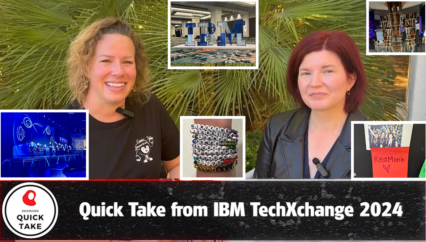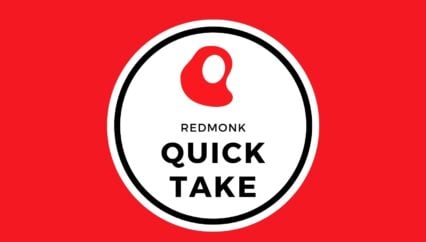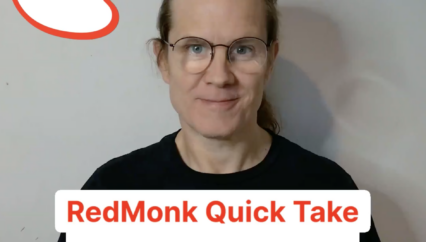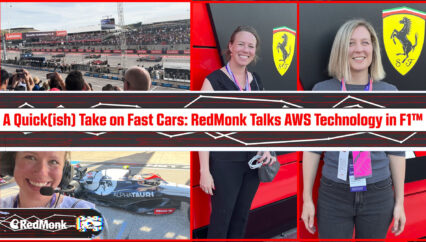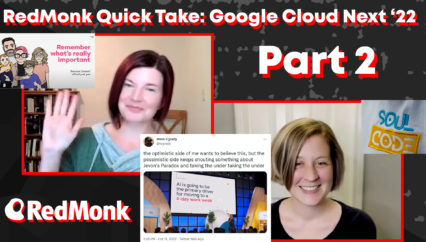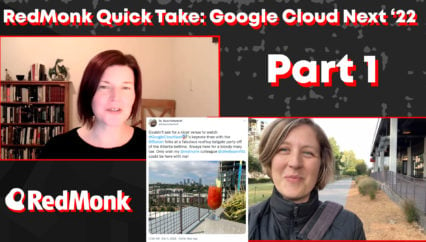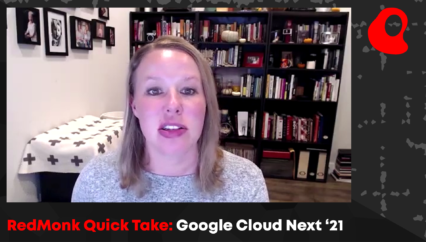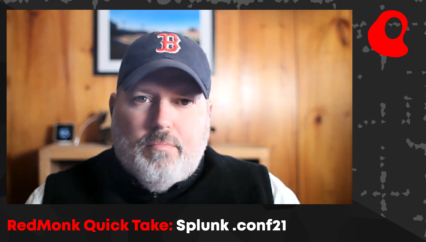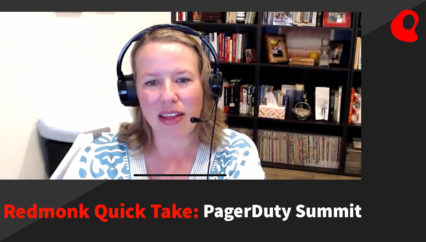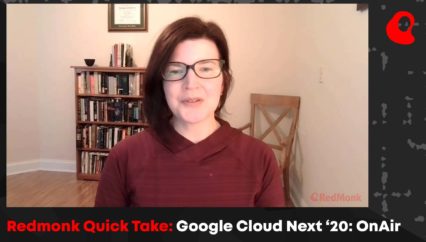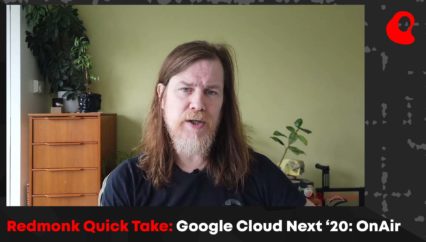Summary
RedMonk’s Kelly Fitzpatrick discusses her key takeaways from AnsibleFest 2022, which she attended in Chicago along with Morgan Harris, RedMonk’s excellent Account and Engagement Manager. Takeaways include impressions on the in-person experience (Ansible puts on quite the keynote and the Chicago Riverwalk is lovely) as well as announcements around Event-Driven Ansible and Project Wisdom, and also include a bonus takeaway courtesy of Morgan.
This was a RedMonk video, sponsored by Red Hat.
Transcript
Hi there. This is Kelly Fitzpatrick with RedMonk, the developer focused industry analyst firm. And I’m here today to talk about AnsibleFest 2022. Now, Ansible is an open source automation technology that is supported by Red Hat. And Red Hat also has a number of commercial offerings such as the Ansible Automation Platform. Now, I have a lot of takeaways from this event. There are a lot of announcements, a lot of components of the event that I could talk about. But for the sake of brevity, I’ve narrowed down my impressions to a few key takeaways.
Now, first and foremost, this event was the first AnsibleFest that was held in person since the COVID-19 pandemic hit. The event was held in Chicago entirely at the Sheraton Grand, which is on the Chicago Riverwalk. The Riverwalk is a 1.25 mile path along the Chicago River, and the the initial opening night reception was supposed to take place outside along the Riverwalk. But because the forecast called for snow in October, the event was moved inside. Now, the return to an in-person event meant the return of things like swag and button walls and booths and even in-person arcade games, which are kind of really old school, if you like that type of thing. But it also meant walking into a keynote room that was packed full of 1000 people with flashing lights and music. And I feel like that type of energy is really hard to capture online. So for me, that was one of the things that really struck me — being surrounded by all of these people — which can be a little nerve wracking these days because COVID is still out there.
Now, the next thing I want to comment on is communication and collaboration, which is perhaps not a surprising topic, given that this is the first time that a giant piece of the Ansible community has been able to gather in person. But what I was not expecting was that communication and collaboration would be such a key point in the day one keynote. Now, Adam Miller in his initial day one talk, talked a lot about some of the challenges of connecting different parts of the Ansible community, which he described as having different segments. Ansible is a very flexible automation technology and is used in different ways, with different constituents. And one of the problems they ran into is that all of these different constituents were communicating, using different tools, some using discord, some using some perhaps older technologies.
So one of the things that Adam talks about is needing to find a solution that would allow folks to use the communication channels that they are used to, but also communicate across channels. So he talks about something called Matrix, which is a technology that they use to bring all of these folks together. And I really like that one of the examples in his keynote of why they decided they had to do this is that there were a group of tech writers associated with Write the Docs who wanted to work on Ansible documentation, but needed some communication channels in order to make this collaboration happen. Clearly, it did happen. And to my mind, whenever you can put tech writers and automation together, that’s like an unstoppable combination.
Next thing I want to talk about is Event-Driven Ansible, which was announced as developer preview at this event. Now what is Event-Driven Ansible? This solves the problem of how you trigger automation when you have more complex systems in place and there isn’t always — you can’t always rely on a human to kick off the automation. And in fact, one of the things I’ve heard about automation, one of the kind of negative things about automation is, “Oh my goodness. Automation is still something that requires a human to kick off.” Well, the whole premise of adventure of an automation is that you don’t. You are automating the automation, and this has a whole bunch of potential applications.
Now, I will say that I got to hear about this. The lab for this was absolutely full, so I didn’t even get near the door. But I’m really interested to see how this particular technology evolves.
The next announcement I want to talk about is around Project Wisdom, which is still in very early stages. Project Wisdom is a collaboration between Red Hat and IBM, and it is an AI model that is used to generate Ansible playbooks from inputs based on just kind of, typed in English. So it translates requests in English into functional pieces of code. I did get to see a session on this, so I got to see a demo. Again, its in very early stages. One of the things — one of the asks coming out of AnsibleFest in this session is that Project Wisdom is asking for help from the community because they are still in the process of training the model. So they’re looking for examples. They’re looking for data to help train the model. And who better to look to for this type of data than the community who is actually using Ansible in ways that often the people who are in charge of making products don’t always know. User information is probably some of the most valuable things that you can get, especially when you’re doing something like training an AI model.
Now, the final takeaway I want to leave you with actually comes from my colleague Morgan. I had asked her to give me a couple of her thoughts. And Morgan in her background, has worked within the tech industry and is very familiar with automation around things like marketing. And she had noted that she was very surprised, pleasantly surprised, to see all these other industries taking advantage of automation. For instance, while we were there at the opening kind of reception, we ran into folks from Paramount, and at first Morgan was like, “What? What is Paramount?” not realizing that this meant like Paramount, like the movie studio that streams things. So Paramount was at AnsibleFest! Very, very cool. And she was also interested to see educational institutions like Harvard there, as well as banks like Ally — which I think she had ran into someone who said that they had sent something like, ten people to AnsibleFest, which is really, really cool.
So AnsibleFest has wrapped, but a lot of the content is available on the online content hub, including all of the keynotes and abbreviated versions of many of the sessions. So check it out if you have a chance.
